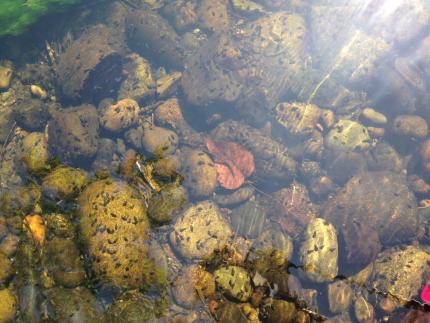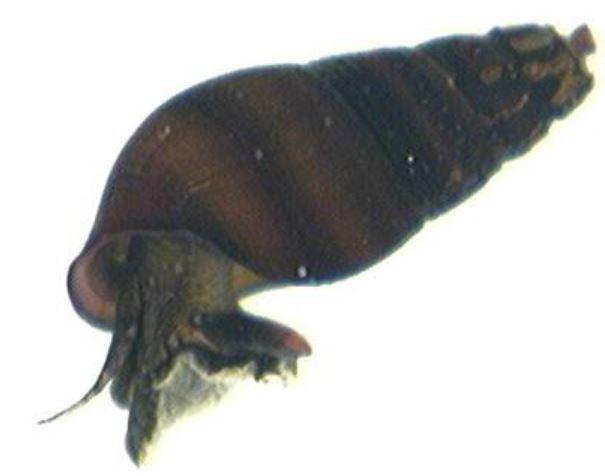Moderate
The barren juga is a freshwater aquatic gastropod. Its population size is considered low and the trend is unknown. Juga species generally require cold, clear, well-oxygenated water; they are sensitive to pollution, and intolerant of warm waters, low dissolved oxygen, or major seasonal fluctuations. Destruction of springs by grazing, logging, and water diversion, for such things as for water supply and fish hatcheries, has already caused extensive extinction of Juga species throughout western North America.
Description and Range
Physical description
Juga species are medium-sized, aquatic, gilled snails with tall conical shells that are thick and heavy. The barren juga is distinguished from other Juga by its larger size, flat-sided shell, which measures a little less than 1 inch. Other morphological differences exist, as well. This genus (Juga) is part of the family Semisulcospiridae.
The taxonomy of the Semisulcospiridae, like most freshwater gastropods, has been based largely on shell morphology, and the tremendous variation makes the current taxonomy problematic and species identification difficult. Current work using reproductive anatomy and DNA to help resolve some of the taxonomic problems will likely result in changes in taxonomy in the future.
Ecology and life history
Juga species are native to the streams and springs of the Pacific Northwest, California, and the Great Basin. The barren juga is found at low elevation large springs and small to medium streams with a level bottom and a stable gravel substrate and fast-flowing, unpolluted, highly oxygenated cold water. These habitats typically lack aquatic macrophytes and have little epiphytic algae.

Juga snails are characterized as rasper-grazers, feeding on both algae and detritus on rock surfaces and deciduous leaf litter.
Species in the genus Juga exhibit separate sexes, with both male and female individuals. The egg masses of Juga are most often found in loose (non-cemented) but stable cobble substrate, with free and fairly vigorous flow through at least the upper substrate layers. Most Juga species appear to breed and lay eggs once a year as adults. Egg masses are located under rocks in the spring, and eggs hatch in one month. Egg laying localities may be reused each year. Juga species live from five to seven years, reaching sexual maturity in three years, and can continue to grow.
Where found, Juga species can comprise over 90 percent of the invertebrate biomass in some streams.
Geographic range
The barren juga was likely historically widespread in the western Columbia River Gorge drainages. Few observations exist, and so historic and current ranges are unknown. In Washington, discrete populations of barren juga are known from Clark and Skamania Counties, possibly on the Gifford Pinchot National Forest.
Climate vulnerability
Sensitivity to climate change
Low-
Moderate
There is limited information on the sensitivity of this species to climate change. The barren juga’s habitat range includes small- to medium-sized creeks and low elevation springs in the Columbia River Gorge area. This species requires cold, highly oxygenated water, and therefore may be sensitive to changes in flow regimes and increases in water temperature that negatively impact dissolved oxygen levels and chemical and biological processes.
Exposure to climate change
Moderate-
High
- Altered flow regimes
- Reduced oxygen
- Increased water temperatures
Conservation
Conservation Threats and Actions Needed
- Fish and wildlife habitat loss or degradation
- Threat: Water diversion; habitat destruction; pollution.
- Action Needed: Protect water quality.
- Resource information collection needs
- Threat: Taxonomic uncertainty may mean one or more taxa are in greater decline.
- Action Needed: Taxonomic clarification.
This species' climate vulnerability is assessed as "moderate to high." Climate vulnerability (PDF) is a way to assess the degree to which a habitat or species is susceptible to and unable to cope with adverse impacts of climate change.
Living with wildlife
References
Blevins, E. and S. F. Jordan. 2015. Species fact sheet: Juga hemphilli. U.S. Department of Agriculture, Forest Service, Interagency Special Status/Sensitive Species Program (ISSSSP).
Strong, E. E. and N. V. Whelan. 2019. Assessing the diversity of Western North American Juga (Semisulcospiridae, Gastropoda). Molecular Phylogenetics and Evolution 136:87-103.
